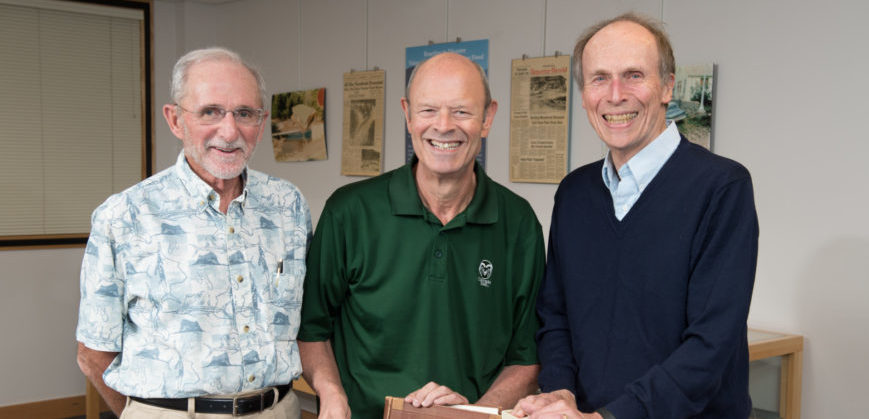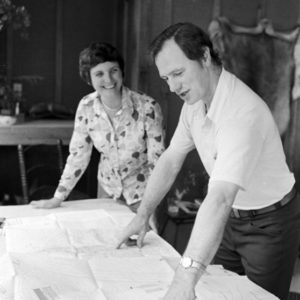
Bob Zimdahl, Gordon “Hap” Hazard and Jim Hansen in the Colorado State University Morgan Library Archive and Special Collections area. Photo by William A. Cotton, CSU Photography
During Ram Welcome, incoming students learn about many of the beloved traditions of Colorado State University: why we paint an A and not a C up on Horsetooth Rock, the definition “stalwart,” and what a Bronze Boot has to do with a Border War, to name a few. New Rams learn what CSU is all about from upperclassmen, who learned from Rams who came before.
But, as Provost Rick Miranda points out, tradition is merely an invitation to history. And history is scholarship, according to James Hansen, professor emeritus of history and author of two volumes tracing the university’s past.
His first book, Democracy’s College in the Centennial State: A History of Colorado State University, was published in 1977. It had been originally planned as a retrospective to celebrate CSU’s centennial in 1970, but when Hansen arrived on campus that year with his newly minted Ph.D. from the University of Denver, he discovered one tiny roadblock.
“There were no university archives,” he recalls. “No one had ever collected any records documenting the history of the university.”
So, before he could write about the first 100 years of Colorado’s land-grant college, Hansen had to collect it. Armed with a memo from President Ray Chamberlain giving him access to any documents he needed, he and his graduate assistant went from college to department filling cardboard boxes with papers and other memorabilia. Then they hauled them to a makeshift space in a corner of Morgan Library and began to sort.
“I had never been trained as an archivist, but I had spent plenty of time working in archives, so I knew enough to arrange materials by who created them rather than by subject,” he said.
By the time Hansen had enough material for his book, he had also established a firm foundation for the University Archives – and made the case for hiring a professional archivist to oversee it while Hansen went back to teaching. John Newman took on the task and the archives found a permanent home in the library, where collections of materials related to the history of Colorado began to grow.
Lessons from 1997 flood
Hansen retired from teaching in 2002, but the next year CSU President Al Yates convinced him that enough had happened since the burning of Old Main in 1970, where the first volume ended, that Democracy’s College needed an update. Democracy’s University was published in 2007, 20 years after the first book and 10 years after the deadly Spring Creek Flood washed away original documents, photographs and other one-of-a-kind materials stored in ground floor offices, including Student Media. Years of bound volumes of the Collegian and negatives of yearbook photos were destroyed and lost to future historians.

“We learned some important lessons from the flood,” says Gordon “Hap” Hazard, who volunteers in the library archives sorting and cataloging photographs. “We had just received a donation that allowed us to move the periodicals section and the archives to the second floor, so we have a complete set of yearbooks and Collegians here, as well as irreplaceable items like the minutes of the meetings of the State Board of Agriculture, but if they had still been stored in the basement, they would have been gone, too.”
Hazard has been working with the university photo collection since he retired from Conference Services in 2004. He draws on his more than 40 years at CSU – he started as a business student in 1974 – to identify images of campus and file them with the proper collections. He also sends out historical photos to a campus mailing list twice a week, to help CSU faculty and staff stay in touch with university history. These can range from a turn-of-the-last-century aerial photo of the faculty with horse-drawn wagons clearing the site for Colorado Field – CSU’s original on-campus stadium – to students walking to classes in bellbottoms in the 1970s.
“Always look for fashions and cars, since they change from year to year,” Hazard says, when trying to place an image in time. “On campus, you can also find clues like how tall the trees are on the Oval – it used to be an open field where cows were pastured and hay was cut – and what buildings are where.”
Hazard and Hansen are combining their expertise for a third volume of CSU history, to be published by the end of the year. CSU’s Sense of Place: A Campus History of Colorado’s Land-Grant University focuses on architecture, and how the evolution from practical land-grant college to major research institution can be traced through its buildings.
People shape the culture
Buildings and recorded events give an “official” perspective, but it’s people’s experiences that shape history and culture. Bob Zimdahl, professor emeritus of agricultural sciences, has been capturing those experiences through interviews with retired CSU faculty and staff. His work, recordings and transcripts now totaling 51 interviews, are stored in the university archives.
Zimdahl retired from teaching in 2005, but was inspired to start collecting oral histories after a chance meeting in 2009 with the late George Splittgerber, emeritus professor of chemistry, who was then 90 years old.
“George had been at CSU since 1943, so I asked him, ‘Has anyone ever asked you to tell your story?’ He said no, and I thought, ‘That’s a shame, because here’s one of the people who created this institution.’ And think about it: When alumni come back to campus, they don’t ask about buildings, they ask about their professors.”
Zimdahl proposed the idea of recording the stories of retired faculty to the Society of Senior Scholars, and found himself with a new volunteer assignment.

Like Hansen’s first foray into archivism, Zimdahl was not a trained interviewer. “I didn’t know what I was doing,” he says. “So I figured I would start with people I knew and they could let me know what I was doing wrong.”
One of his first oral histories was with friend and ag sciences colleague Tom Sutherland. Sutherland and Splittgerber are among the four of Zimdahl’s subjects who are now deceased, which underscores the importance of capturing their accumulated knowledge and wisdom while we can.
“I do wait until they’ve been retired for about five years, so they have some time to develop some perspective,” Zimdahl says. “Only one subject wanted to make changes to the transcript when he reviewed it, and then he just added things he remembered after we talked. Everyone always says, ‘Thank you for asking.’”
He admits that the existing interviews are predominantly with male faculty, “because that’s who was hired back then.” Zimdahl himself is on the record, because one of his student assistants insisted on asking him the standard list of questions.
Other history keepers
In addition to Zimdahl’s project, various colleges have started collecting oral histories from emeritus faculty and staff who have been instrumental in their development. The Legacies Project in the College of Health and Human Sciences has won national recognition, and the College of Business is celebrating its 50th anniversary with a wide range of historical recollections.
Zimdahl, now 81, has recently decided to retire from the oral history game to concentrate on the fifth edition of a textbook and writing a memoir for his children, as well as raising sheep as a “peasant farmer” outside of town. However, the collecting will continue, with support from the Office of the President, which has already assigned staff to begin interviewing retirees as CSU approaches its 150th anniversary in 2020.
“Knowing where we’ve been is vital to knowing where we want to go in the future,” says Provost Miranda.
 The future of the archives at Morgan Library – the land-grant within the land-grant university, as Dean of Libraries Patrick Burns calls it – is in digitization of fragile paper documents and aging photos. A fund to support the work of the archives has been included in CSU’s $1 billion “State Your Purpose” fundraising campaign. Click here to learn more and donate.
The future of the archives at Morgan Library – the land-grant within the land-grant university, as Dean of Libraries Patrick Burns calls it – is in digitization of fragile paper documents and aging photos. A fund to support the work of the archives has been included in CSU’s $1 billion “State Your Purpose” fundraising campaign. Click here to learn more and donate.